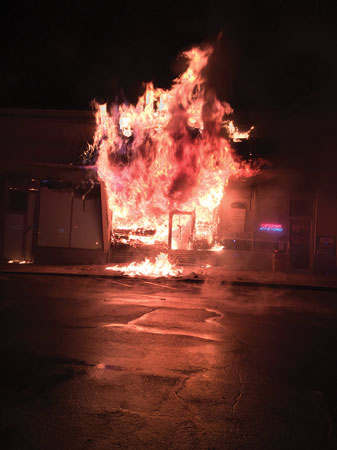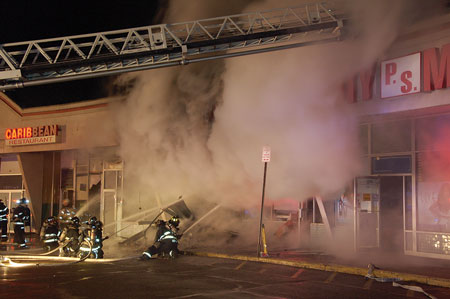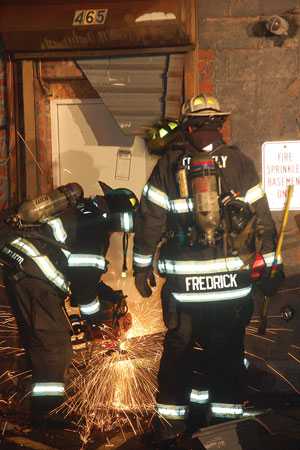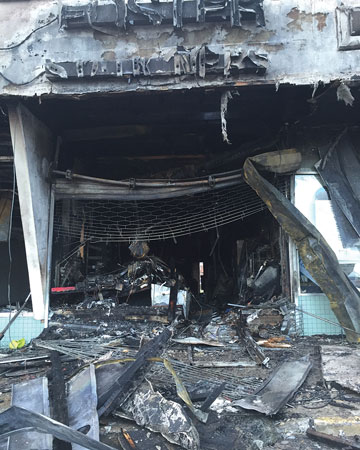
By Steven Naylis
Over the past few years, I have been fortunate to attend the Fire Department Instructors Conference (FDIC) International. I learned a number of valuable lessons that I was able to put into practice at this fire. First was the constant emphasis on knowing the buildings to which I may be called. Second was to begin a fire attack with large-caliber streams when confronted with a large body of fire. Third was to get the right resources early on in the incident rather than play catch-up to achieve rapid access and quick knockdown.
On April 3, 2016, at 0414 hours, the Bergenfield (NJ) Fire Department was dispatched for a reported fire in a commercial structure. On the initial alarm, the fire department responds with three chief officers, four engines, a truck, and a rescue company. Within minutes, the local police department was on scene reporting a fully involved fire in the structure. Based on this report, the first responding chief requested an additional truck company from a mutual-aid town. On arrival, the chief transmitted a working fire, having observed heavy fire conditions with a large fire load. This brought covering companies into town. Soon thereafter, Command requested a second-alarm assignment, which brought an additional two engines and truck to the scene. I was the captain of the first-due engine company.
 |
| (1) A heavy volume of fire venting through the front store windows and extending into the overhanging soffit dictated a rapid fire attack with large-caliber streams and the need for extensive truck work to cut off the spread of fire. (Photo by Jason Lanzilotti.) |
The involved store was a one-story stationery business, approximately 25 feet × 75 feet, located roughly in the middle of a row of stores in a strip mall. The strip mall was built after World War II. Construction was a combination of gypsum board walls on metal and wood studs. There were multiple ceilings, including a suspended ceiling with ceiling tiles and grid work, a metal ceiling, and fiberboard tiles on wood lath. They all were covered by a wood roof with built-up roofing material.
On our arrival, we observed flames coming out of the front of the store that were starting to spread north and south to the adjacent stores. The engine chauffeur secured a hydrant laid in with two three-inch supply hoses; our probationary firefighter staffed the hydrant position. The hydrant was on a 24-inch main, so I knew we would have plenty of water for this fire.
 |
| (2) Large-caliber handlines were used to hit the fire from the front and to control extension into the Bravo exposure. (Photo by Bill Tompkins.) |
When the engine pulled up, I ordered my crew to stretch the 2½-inch preconnect with smooth bore nozzle for an aggressive attack. While members were putting the line in service, two helium tanks that were inside failed and burst, causing a rush of fire out of the front windows. I told my crew to stay off to the side at a 45° angle so we would be protected in case any other tanks were inside and ready to fail. Thankfully, there were just the two tanks.
Once the ladder arrived on scene, the crew went to the roof and started making inspection holes to locate any fire spreading to the other stores in the common cockloft area. While water was being put on the fire, the rescue company started cutting the roll-down security gate to enable an interior attack. Water was being applied for roughly two minutes before we ran out of our 500 gallons in the booster tank. This enabled us to contain the fire while the public water supply was established. I wasn’t too concerned about running out of water because there was no life hazard in the structure and my crew was standing outside during the initial attack.
 |
| (3) The rear of the stores had multiple doors that needed extensive forcible entry. A rotary saw was used on the roll-down door that exposed the metal door behind it. Heavily fortified doors, particularly in the rear, are common in strip malls. (Photo by Bill Tompkins.) |
In the rear, companies encountered more roll-down security gates, padlocks, and reinforced rear doors. Crews had to force multiple rear doors using power saws, hydraulic spreading tools, and conventional methods (irons). It was by no means an easy task. With the hoseline unable to get in through the front or to have the reach to hit the back of the store, crews had to stretch an additional 2½-inch attack line in the rear to get in and fully extinguish the fire. The fire load was so large that hose teams had a tough time getting in and checking for extension and hot spots.
While the rescue company was working in the front of the structure trying to cut away the roll-down security gate for the engine crew, the soffit collapsed on top of two members without warning. The ceiling that fell knocked one member to his knees; the other member remained standing. A Mayday was transmitted for the down firefighter but was quickly canceled because the two members were able to get out from under the debris. The local ambulance corps checked out the members, who were cleared for duty shortly thereafter. When the Mayday was given, crews did not stop their operations of putting out the fire. This is very important for departments to understand: Fire suppression must continue unless the incident commander orders otherwise.
 |
| (4) The storefront after knockdown shows a mangled roll-down gate and debris from the collapsed soffit that had to be overcome during the fire attack. (Photo by Jason Lanzilotti.) |
The weather at the time of the fire was cold and deteriorating. The wind started to pick up, and rain started to turn to sleet and snow. The wind was so bad at one point that the empty shopping carts in the parking lot were scattered all over. Thankfully, with the quick work of the engines and coordinated truck company, the fire was knocked down before the wind made our jobs much worse.
The fire was contained to the one business and did not spread to any of the other stores. Damage in the adjacent stores was limited to smoke; minor water damage; and inspection holes in ceilings, roof, and walls to ensure there was no hidden fire.
Lessons
Several key points were reinforced during this fire.
Commercial building fires with heavy fire demand large-caliber streams. Three 2½-inch lines were used.
Know your buildings. This vintage strip mall had a common cockloft with multiple ceilings and roofs. Five truck companies were used to perform forcible entry and ventilation and open up ceilings. Don’t hesitate to call for the resources you will need.
When the Mayday was sounded, fireground operations did not stop. The members stayed on point and on task while assigned rapid intervention crews handled the Mayday. A swift and aggressive fire attack kept this fire to the original store of involvement because the basics of commercial fire attack were followed.
STEVEN NAYLIS is a career and volunteer firefighter with 10 years of experience. He is certified by the NJ Division of Fire Safety at the incident management level 1 and is also a level 1 fire instructor. He is a regular attendee of FDIC International.
Taxpayers and Strip Malls: Construction and Tactics
Surprise Packages
ANATOMY OF A STRIP MALL FIRE
Fire Engineering Archives

